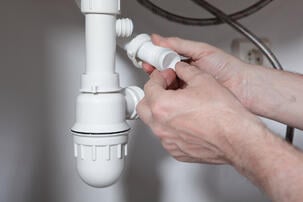Everyone has got their own individual theory with regards to Plumbing Basics For Every Home: The HomeTriangle Guide.

Plumbing is a vital aspect of any type of home, in charge of providing clean water for alcohol consumption, cooking, and bathing, in addition to removing wastewater securely. Understanding the essentials of home plumbing is crucial for each home owner to make sure correct upkeep, troubleshooting, and, if needed, repair services. In this beginner's guide, we'll cover the fundamental concepts of home plumbing to aid you become a lot more aware of exactly how it functions.
Water Supply System
The water system brings tidy water into your home from a metropolitan water resource or a personal well. It consists of a major water line that attaches to your home's plumbing system, typically situated underground. A water meter determines the quantity of water taken in, while a shut-off valve permits you to control the flow of water right into your home.
Plumbing Components
Plumbing components are gadgets that deliver water to numerous parts of your home and include sinks, faucets, toilets, showers, tubs, and appliances such as dish washers and washing makers. Each fixture is attached to the water supply system by means of pipes and installations and may have its shut-off shutoff for upkeep or emergency situations.
Water Heating Unit
The water furnace is accountable for home heating water for domestic usage, consisting of bathing, cooking, and cleaning. Typical sorts of water heaters include tank-type hot water heater, tankless (on-demand) hot water heater, and heat pump hot water heater. The hot water heater is connected to the water system system and supplies hot water to plumbing fixtures as needed.
Water drainage System
The drainage system eliminates wastewater from your home and lugs it away to a sewer treatment facility or septic system. It contains a network of pipelines, fittings, and fixtures that move wastewater from plumbing components to the primary drain line or sewage-disposal tank. Correct drainage is vital to stop blockages, back-ups, and sewer leaks.
Ventilation System
The air flow system helps maintain appropriate atmospheric pressure and prevent sewage system gases from entering your home. Air vent pipes, additionally referred to as vent stacks, prolong from plumbing components to the roof covering, allowing drain gases to leave securely outdoors. Ventilation pipes additionally enable air to go into the water drainage system, helping with smooth wastewater flow and protecting against suction or vacuum cleaner impacts.
Typical Plumbing Tools
Having the right devices on hand is essential for executing fundamental plumbing repair services and upkeep tasks. Typical plumbing tools consist of flexible wrenches, monkey wrench, pliers, pipe cutters, hacksaws, plungers, augers (or drain snakes), and Teflon tape. Having these tools conveniently offered can aid you tackle minor plumbing problems successfully.
Basic Plumbing Repair Services
While some plumbing repair services may need professional aid, numerous typical problems can be addressed with fundamental DIY techniques. Understanding exactly how to repair a leaking faucet, unclog a drain, change a bathroom flapper, or fix a leaking showerhead can conserve you money and time on plumbing repairs.
Verdict
Recognizing the basics of home plumbing is important for every single property owner to maintain a risk-free, useful, and reliable plumbing system. By acquainting yourself with the water system system, plumbing fixtures, drain system, air flow system, typical plumbing tools, and standard fixings, you can with confidence address small plumbing issues and guarantee your home's plumbing system runs efficiently.
Understanding Basics of Home Plumbing System: A Beginner's Guide
The Main Components of Your Home Plumbing System
The Water Supply System
This system is responsible for transporting fresh water into your home. It usually has a main water line that splits into two branches: one directed towards cold water services and the other connected to a water heater for hot water. The pressure is key here; it ensures water reaches all parts of your house.
The Drainage System
Once water has been used, it becomes wastewater that needs to be removed from your home. This is where the drainage system comes into play. It includes all the pipes that carry wastewater and sewage away from your house to sewage treatment facilities or septic tanks.
The Vent System
The vent system prevents sewer gases from entering your home and helps maintain the pressure balance that allows wastewater to flow out properly. These vents usually exit through the roof of your house.
Water Heating System
For those who enjoy hot showers or using hot water for cleaning, the water heater is a crucial part of the plumbing system. It can be a tankless system, which heats water on demand, or a traditional water tank model.
Common Plumbing Problems and Basic Troubleshooting
Plumbing systems, while designed to be durable, can face issues like clogged drains, leaky faucets, or low water pressure. Here are some basic troubleshooting tips:
Clogged Drains
Use a plunger or a plumber's snake to try and dislodge whatever is blocking the drain. Regular cleaning can prevent clogs.
Leaky Faucets
Often caused by worn-out washers or gaskets, these can usually be replaced by someone with basic DIY skills.
Low Water Pressure
This might be due to sediment build-up in your fixtures or a leak somewhere in your water line. Cleaning out aerators or seeking a professional to detect leaks might be necessary.
Preventive Maintenance Tips
Maintaining your plumbing system is key to avoiding emergencies. Regularly check for leaks, avoid disposing of grease down the sink, and have your system inspected by a professional plumber at least once a year.

I found that blog entry on What to Know About Plumbing: Basics, Tips, and Insights while exploring the internet. You should pause to share this blog entry if you appreciated it. Thanks for being here. Revisit us soon.
Click Here